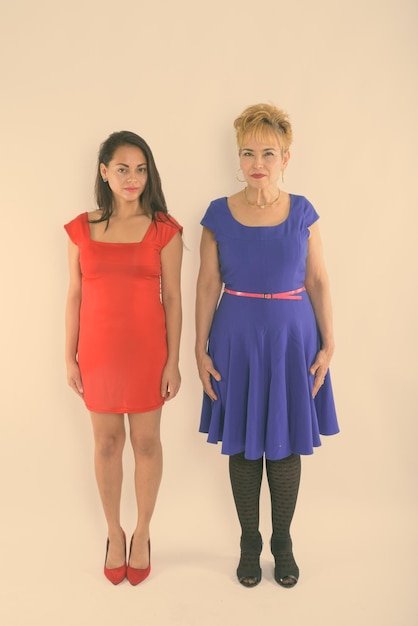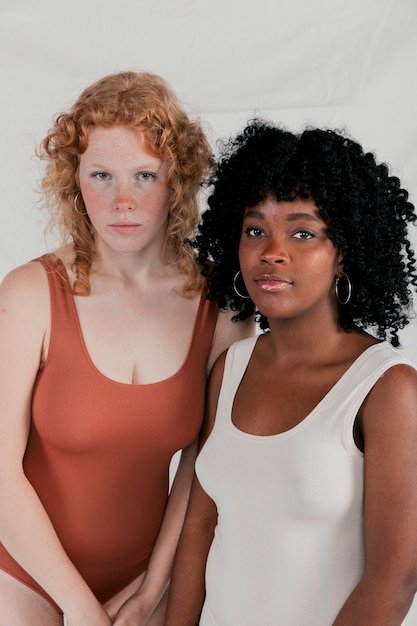Size inclusivity in hauls is an evolving trend where US fashion brands are increasingly catering to diverse body sizes, reflecting a broader demand for representation and accessibility in fashion.
The fashion industry is slowly but surely recognizing the importance of size inclusivity in hauls. Are US brands finally stepping up to meet the demands of a diverse customer base?
Understanding Size Inclusivity in Fashion
Size inclusivity in fashion goes beyond simply offering a few larger sizes. It’s about ensuring that clothing is available in a wide range of sizes, designed to fit and flatter different body types, and marketed to a diverse audience.
For years, the fashion industry has been criticized for its limited size ranges, which often exclude or marginalize individuals who don’t fit the narrow standards of beauty. However, there’s a growing awareness of the need for more inclusive sizing and representation.
The Historical Context of Size Inclusivity
Historically, fashion has catered primarily to a specific body type, often neglecting the needs of plus-size individuals. This has led to a lack of options and limited representation in mainstream media.
The Current Landscape of Size Inclusivity
Today, more brands are recognizing the importance of size inclusivity and are expanding their size ranges accordingly. Additionally, social media influencers are playing a significant role in advocating for greater inclusivity and showcasing fashion for all body types.
- Increased Awareness: Social media campaigns and influencer collaborations have helped raise awareness of the need for size inclusivity.
- Expanding Size Ranges: Many brands are extending their size ranges to include a wider variety of body types.
- Improved Fit and Design: Brands are investing in better fit and design to ensure that clothing is comfortable and flattering for all sizes.
Ultimately, size inclusivity in fashion is about promoting body positivity and ensuring that everyone has access to stylish and well-fitting clothing, regardless of their size.
The Challenges US Brands Face
While many US brands are making strides toward size inclusivity, they still face significant challenges. These range from design and manufacturing complexities to marketing and representation issues.
One of the primary challenges is the cost and complexity of creating clothing in a wider range of sizes. It requires more resources, different design approaches, and additional manufacturing considerations.

Design Complications in Plus-Size Clothing
Designing clothing for larger sizes is not as simple as scaling up existing designs. It often requires adjustments to proportions, construction, and fabric choices to ensure a comfortable and flattering fit.
Manufacturing and Cost Considerations
Producing clothing in a wider range of sizes can be more expensive due to the need for additional patterns, materials, and specialized equipment. These costs can be a barrier for smaller brands.
- Pattern Grading: Creating accurate patterns for a wide range of sizes requires expertise and attention to detail.
- Fabric and Construction: Different fabrics and construction techniques may be needed to provide support and comfort for larger sizes.
- Inventory Management: Managing inventory for a diverse size range can be complex, requiring careful planning and forecasting.
Overcoming these challenges requires a commitment from brands to invest in inclusive design practices and sustainable manufacturing processes.
Brands Leading the Way in Size Inclusivity
Despite the challenges, several US brands are leading the way in size inclusivity, setting a positive example for the rest of the industry. These brands are not only offering a wider range of sizes but also prioritizing fit, quality, and representation.
These brands are often recognized for their commitment to body positivity and their efforts to create clothing that empowers individuals of all sizes to feel confident and stylish.
Universal Standard
Universal Standard is a brand dedicated to providing high-quality, stylish clothing in sizes 00-40. They prioritize fit and design, ensuring that their clothing looks and feels great on every body.
Aerie
Aerie, American Eagle’s lingerie and activewear brand, has gained recognition for its unretouched advertising campaigns featuring models of all sizes and ethnicities. They offer a wide range of sizes and promote body positivity.

- Good American: Founded by Khloé Kardashian, Good American offers denim and clothing in sizes 00-32, with a focus on fit and quality.
- Torrid: Torrid is a plus-size retailer that offers trendy and stylish clothing in sizes 10-30, catering to a younger demographic.
- Madewell: Madewell has expanded its size range to include plus sizes, offering stylish and well-fitting clothing for a wider range of body types.
These brands demonstrate that size inclusivity is not only possible but also a successful business strategy.
The Role of Social Media and Influencers
Social media and influencers have played a crucial role in driving the size inclusivity movement forward. They have helped to raise awareness, promote body positivity, and showcase fashion for all body types.
Influencers often share their clothing hauls, styling tips, and personal experiences, providing valuable insights and inspiration for their followers. They also hold brands accountable and advocate for greater inclusivity.
Influencer Marketing Strategies
Brands are increasingly partnering with influencers to promote their size-inclusive clothing lines. These collaborations can be highly effective in reaching a diverse audience and building brand awareness.
User-Generated Content
Platforms like Instagram and TikTok allow individuals to share their own fashion hauls and styling tips, creating a community of support and inspiration. This user-generated content can be incredibly powerful in promoting body positivity and challenging traditional beauty standards.
By leveraging social media and influencer marketing, brands can connect with a wider audience and demonstrate their commitment to size inclusivity.
How to Shop for Size-Inclusive Clothing
Shopping for size-inclusive clothing can be a rewarding experience, but it requires some research and planning. It’s important to find brands that prioritize fit, quality, and style, and that cater to your specific needs and preferences.
Here are some tips to help you shop for size-inclusive clothing:
Research Brands
Take the time to research brands that offer a wide range of sizes and that prioritize fit and quality. Look for brands that have positive reviews and a strong reputation for inclusivity.
Read Reviews and Check Size Charts
Before making a purchase, read reviews from other customers to get an idea of the fit and quality of the clothing. Also, be sure to check the brand’s size chart and compare it to your own measurements.
- Consider Fabric and Fit: Pay attention to the fabric composition and construction of the clothing. Look for fabrics that are comfortable and that drape well on your body.
- Utilize Virtual Try-On Tools: Some brands offer virtual try-on tools that allow you to see how clothing will look on your body before you make a purchase.
- Embrace Body Positivity: Remember to embrace body positivity and shop for clothing that makes you feel confident and comfortable.
By following these tips, you can find size-inclusive clothing that fits and flatters your body and that makes you feel great.
The Future of Size Inclusivity in Fashion
The future of size inclusivity in fashion looks promising, with more brands recognizing the importance of catering to a diverse customer base. As awareness continues to grow and technology advances, we can expect to see even greater progress in the years to come.
From improved design and manufacturing processes to more inclusive marketing and representation, the fashion industry is slowly but surely embracing size inclusivity as a core value.
Technological Advancements
3D body scanning and virtual try-on technologies are making it easier for brands to create clothing that fits a wider range of body types. These technologies also allow customers to try on clothing virtually, reducing the risk of returns.
Sustainability and Ethical Practices
As consumers become more aware of the environmental and social impact of their clothing choices, brands are prioritizing sustainability and ethical practices. This includes using eco-friendly materials, reducing waste, and ensuring fair labor practices.
- Personalized Shopping Experiences: AI and machine learning are being used to create personalized shopping experiences that cater to individual preferences and body types.
- Inclusive Marketing Campaigns: Brands are increasingly featuring diverse models in their advertising campaigns, promoting body positivity and inclusivity.
- Collaboration and Partnerships: Brands are collaborating with influencers and advocacy groups to promote size inclusivity and body positivity.
Ultimately, the future of size inclusivity in fashion is about creating a more equitable and representative industry that celebrates diversity and empowers individuals of all sizes to feel confident and stylish.
| Key Points | Brief Description |
|---|---|
| ✨ Size Inclusivity | Offering a wide range of sizes in clothing. |
| 👗 Design Challenges | Creating designs that fit and flatter diverse body types. |
| 📢 Social Media | Influencers promoting inclusivity and body positivity. |
| 🛍️ Shopping Tips | Researching brands and checking size charts before purchasing. |
Frequently Asked Questions
▼
▼
▼
▼
▼
Conclusion
In conclusion, while the journey towards full size inclusivity in hauls within the US fashion market is ongoing, significant strides are being made. Brands are increasingly recognizing the importance of catering to a diverse customer base, driven by social media influence and a growing demand for body positivity. As technology continues to evolve and awareness spreads, the future of fashion promises greater equity, representation, and empowerment for individuals of all sizes.